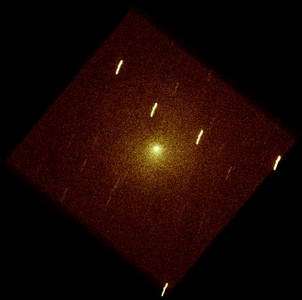NASA Swift Satellite Offers a Different View of the Great Comet Collision

Scientists using the Swift satellite witnessed a tale of fire and ice today, as NASA's Deep Impact probe slammed into the frozen comet Tempel 1. The collision briefly lit the dim comet's surface and exposed, for the first time, a section of ancient and virgin material from the comet's interior.
Image of Comet Tempel 1 taken on 29 June 2005 using the Swift Ultraviolet/Optical Telescope (UVOT) through an ultraviolet filter centered on 2600 Angstroms. The image has been compensated for the motion of the comet on the sky, so its background stars appear as streaks on the sky instead of as points.
Click here to download a movie that shows the sudden brightening and gradual decline in ultraviolet light during first four hours after the Deep Impact experiment on Comet Tempel 1.
Swift is providing the only simultaneous multi-wavelength observation of this rare event, with a suite of instruments capable of detecting optical light, ultraviolet, X-rays and gamma rays. Different wavelengths reveal different secrets about the comet.
So far, after a set of eight observations each lasting about 50 minutes, Swift scientists have seen a quick and dramatic rise in ultraviolet light, evidence that the Deep Impact probe struck a hard surface, as opposed to a softer, snowy surface. A movie of the ultraviolet observations is available at this web site (left) and at the Swift Mission Operations Center .
More observations and analysis are expected in the coming days from teams at NASA and Penn State and in Italy and the United Kingdom.
"We have now observed this comet before, during, and after the collision," said Dr. Sally Hunsberger of the Swift Mission Operation Center at Penn State. "The comparison of observations at different times -- that is, what was seen, when and at what wavelength -- should prove to be quite interesting."
Most of the debris observed in ultraviolet light likely came from once-icy surface material heated to 2,000 degrees by the impact. X-rays have not been detected yet but analysis will continue throughout the week. X-rays are expected to be emitted from newly liberated sub-surface material lifted into the comet's coma, which is then illuminated by the high-energy solar wind from the Sun. It takes about a day, however, for the material to reach the coma.
"Some called it fireworks today, but it really was more like 'iceworks,'" said Prof. Keith Mason, Director of Mullard Space Science Laboratory at University College London, who organized the Swift observations. "Much of the comet is ice. It's the other stuff deep inside we're most interested in -- pristine material from the formation of the solar system locked safely below the comet's frozen
surface. We don't know exactly what we kicked up yet."
Swift's "day job" is detecting distant, natural explosions called gamma-ray bursts and creating a map of X-ray sources in the universe, far more energetic "fireworks." Indeed, since beginning this Deep Impact campaign on July 1 -- in addition to seeing comet Tempel 1 -- Swift has seen a gamma-ray burst and a supernova and has discovered a black hole in the Milky Way galaxy. The satellite's speed and agility, however, provides an important complement to the dozens of other world-class observatories in space and on Earth observing the Deep Impact experiment. Swift will continue to monitor the comet this week.
Comets are small astronomical objects usually in highly elliptical orbits around the sun. They are made primarily of frozen water, methane and carbon dioxide with a small amount of minerals. They likely originate in the Oort Cloud in the outskirts of the solar system. Comet Tempel 1 is about the size of Washington, D.C. Some scientists say that comets crashing into Earth billions of years ago brought water to our planet.
A comet becomes visible when radiation from the Sun evaporates its outer layers, creating a coma, the thin atmosphere. Solar wind impacts the coma to form the comet's tail of dust and gas, which always points away from the Sun. Comets are best visible when they enter the inner solar system, closer to the Sun.
"The Deep Impact collision was the most watched astronomical event of the year," said Dr. Neil Gehrels, Swift Principal Investigator at NASA Goddard Space Flight Center in Greenbelt, Md. "All the 'big-guns' observatories tracked it. In the next few days, as material continues to fly off the comet from newly created vents, we will see whether Swift can offer new insight into comets by virtue of the high-energy light we are seeing."
Prof. Mason and Prof. Alan Wells of the University of Leicester in England are at the Swift Mission Operation Center to help with the observation.
Links:
swift.gsfc.nasa.gov
swift.sonoma.edu
Source: Penn State

















